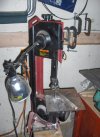Blade Break-In Procedure
All band saw blades, regardless of the manufacturer, need to be "broken in". When new, the teeth are just too sharp. Cutting at full rate will cause fracturing of the feather edges which will lead to premature blade failure. Breaking in a saw blade wears off this ultra sharp edge and allows the blade to retain its cutting ability longer. Each manufacturer has their own preferred method for blade break-in. However, they all share the same principles:
Maintain recommended band speed
Reduce feed pressure to ½ normal rate
Run at these settings for the first 50 square inches of material cut (150 square inches on mild and low carbon steel)
Note: If you are unsure what the normal feed pressure is, start light. Increase feed pressure until good, curly chips start to form. After cutting the recommended area, slowly increase the feed pressure until you reach your desired cutting rate.
Special consideration must be given while breaking in a saw blade on nickel-based alloys. (Stainless Steel, Inconel, Hastelloy, D2 Tool Steel, etc.) These alloys tend to work harden very quickly; therefore, sufficient feed pressure must be applied during the break-in period to remove some material. As a general rule, alloys sawed at lower speeds need more pressure during break-in period.

